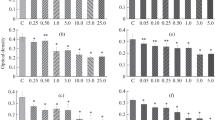Abstracts
Euglena gracilis 277, a unicellular green alga, demonstrated remarkable ability to transport Nd3+ to the cell compartments. For a given amount of Nd3+ and cells, the results of ICP-AES indicated that the cellular uptake of Nd3+ was independent of Nd3+ concentration in the bulk solution. The average uptake of Nd3+ per cell (m Nd) is proportional to a parameter ξ — the ratio of neodymium content to the cell counts of the system. A novel approach for probing cellular neodymium by tetraiodotetra chlorofluorescein (I4TCF) has been devised. Data derived from the cryosections of I4TCF-Nd3+ stained cells and EDAX of the fast freezing ultrathin cryosections indicate that Nd3+ is distributed over the cell compartments. Chloroplasts are the major compartments as the residence of Nd3+ in the alga. The transport should be against a concentration gradient of Nd3+ on the order of five, even higher. It is proposed that a calcium ion channel would play an important role in the Nd3+ transportation.
Similar content being viewed by others
References
Brown, P. H., Rathjen, A. H., Graham, R. D. et al., Rare earth elements in biological systems, in Handbook of Physics and Chemistry of Rare Earths (eds. Gschneider, K. A. Jr., Eyring, L.), Vol. 13, Amsterdam: Elsevier Science Publisher, 1990, 423.
Ni, J. Z., Bioinorganic chemistry of Rare Earth Elements (in Chinese), Beijing: Science Press, 1995.
Hirano, S., Suzuki, K. T., Exposure, metabolism and toxicity of rare earths and related compounds, Environmental Health Perspectives, 1996, 104(17): 85.
Sileio, A., Mauro, B., Lanthanide(III) chelates for NMR biomedical applications, Chemical Society Reviews, 1998, 27: 19.
Rath, C., Joseph, P. M., A comparison of beam-hardening artifacts in X-ray computerized tomography with gadolinium and iodine contrast agents, Medical Physics (Woodbury), 1995, 22(12): 1977.
Haener, R., Hall, J., The sequence-specific cleavage of RNA by artificial chemical ribonucleases, Antisense-Nucleic Acid Drug Dev., 1997, 7(4): 423.
Evans, C. H., Interesting and useful biochemical properties of lanthanides, TIBS, 1983, 445.
Jin, C. Z., Kang, L., Sheng, Z. Q. et al., Cytochemical behavior of neodymium inEuglena gracilis, Academic Periodical Abstracts of China (in Chinese), 1998, 4(8): 976.
Wang, L. F., Ma, Z. L., Wu, J. G. et al., The structures and electrical properties of diiodofluorescein and tetraiodotetrachlorofluorescein-Nd3+ complexes, Chinese Science Bulletin (in Chinese), 1986; 31(5): 350.
Inoué, S., Video Microscopy, New York: Plenum Press, 1986.
Yu, Y. F., Huang, H., Ling, Y. P. et al.,In situ cryofixation and cryoultramicrotomy on biological tissue, Chinese Journal of Physical Medcine (in Chinese), 1993, 15(3): 191.
Alberts, B., Bray, D., Lewis, J. et al., Molecular Biology of the Cell, 3rd ed., New York & London: Garland Publishing, 1994, 482.
Lehrmann, R., Seelig, J., Absorption of Ca2+ and La3+ to bilayer membranes: measurement of the absorption enthalpy and binding constant with titration calorimetry, Biochim. Biophys. Acta, 1994, 1189: 89.
Liu, P. J., Wang, W. Y., The preparation and properties of I4TCF, Applied Chemistry (in Chinese), 1990, 7(2): 80.
According to Mamdanian algorithm, for every output component indexj, the inference relation of Song, Zhang Y. M., Zhang, Y. M., Qu, X. D. et al., Study on the properties of tetrachlorotetraiodofluorescein-rare earth complex, Rare Earth (in Chinese), 1992, 6: 42.
Reed, S. J. B., Electron microprobe analysis, 2nd ed., London, New York, Oakleigh: Cambridge University Press, 1993, 206.
Yang, J. L., Li, H. J., Yan, H. T. et al., Study on the spectroscopy of chlorophyll-rare earth, J. of Chinese Rare Earth Society (in Chinese), 1992, 10: 86.
Cheng, Y., Chen, B. W., Lu, J. F. et al., The reaction of lanthanide ions with n-doxyl stearic acids and its utilization for the ESR study on the permeability of lipid-bilayer of erythrocyte membrane to gadolinium ions, Inorganic Biochemistry, 1998, 69: 1.
Tytgat, J., Daenens, P., Effect of lanthanum on voltage-dependent gating of a cloned mammalian cloned neuronal potassium channel. Brain Research, 1997, 749(2): 232.
Lansman, J. B., Blockade of current through single calcium channels by trivalent lanthanide cations, Effect of ionic radius on the rates of ion entry and exit, J. Gen. Physiol., 1990, 95: 679.
Wolken, J. J.,Euglena: An Experimental Organism for Biochemical and Biophysical Studies, Appleton: Appleton-Century-Crofts, 1967.
Miller, R. J., Multiple calcium channels and neuronal function, Science, 1987, 235: 46.
Author information
Authors and Affiliations
About this article
Cite this article
Kang, L., Shen, Z. & Jin, C. Neodymium cations Nd3+ were transported to the interior ofEuglena gracilis 277. Chin.Sci.Bull. 45, 585–592 (2000). https://doi.org/10.1007/BF02886032
Received:
Issue Date:
DOI: https://doi.org/10.1007/BF02886032




